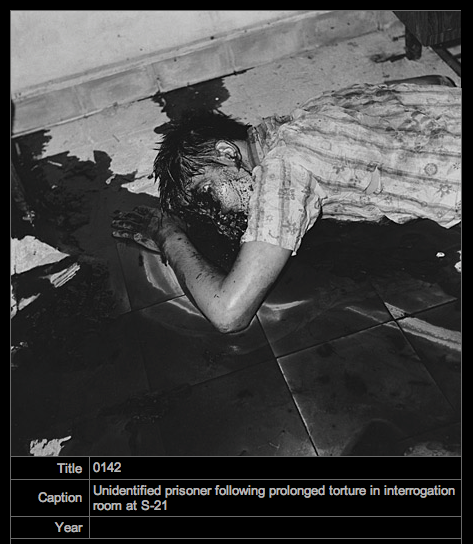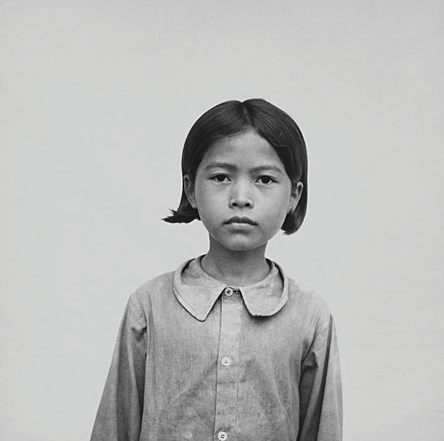Saturday’s New York Times included these stories: First, the confirmation of Michael B. Mukasey for attorney general had hit a “rough patch” because Democrats were suggesting that they might oppose confirmation if the nominee “did not make clear that he opposed waterboarding and other harsh interrogation techniques that have been used against terrorism suspects.” Second, a review of the movie “Saw IV” advised viewers to “Imagine every conceivable form of torture, then add the inconceivable.” Third, a report on the photographs, and photographer, used by the Khmer Rouge to document the arrival of those who had been brought to the Toul Sleng prison to be tortured and killed. You might see a pattern. . . .
Do you also see a sliding scale? Say, from the torture we do, which the administration would like to think is a matter of semantics, to the torture we imagine for cheap thrills, which receives the stern rebuke of an R rating while remaining business as usual at the cineplex, to the torture done by others, which is the subject of documentary reportage. Even so, the Times story on the prison photographs is a service. The problem they, and we, face is how to confront torture without inadvertently contributing to its normalization. News media should be faulted at times for not showing the harm done by those acting in our name, but we don’t want the news to become “Saw XXX” in real time. It should be said, however, that surely it becomes too easy to minimize torture when both Gonzales and Mukasey have said they oppose torture while condoning its practice, and when audiences watch torture scenes on film and TV that they know involve no real pain. That is why we need to see this:
This is one of the images at the Tuol Sleng Museum website. It should be said that the Times did not include this photo in its story. Perhaps they should be faulted for that. I don’t think so, because what they did show was even more horrific:
She is another “unidentified prisoner.” She also is a young girl who subsequently will have been tortured and killed. I can’t imagine. . . . And if anyone says that at least the US government doesn’t torture little girls, we already have slipped too far into the abyss.
Photographs from the Tuol Sleng Museum of Genocide, http://www.tuolsleng.com/.


[…] No Caption Needed wrote an interesting post today on Seeing TortureHere’s a quick excerpt Saturday’s New York Times included these stories: First, the confirmation of Michael B … harsh interrogation techniques that have been used against terrorism suspects.” Second, a review … , and when audiences watch torture scenes on film and TV that they know involve no real pain. That is why […]
Powerful, shocking stuff. You can only look at that kind of image obliquely, but the image demands to be viewed, right now, especially by those of us who live in a country that currently engages in torture in secret prisons, Guantanamo Bay, and military facilities like abu ghraib (if you havent read about extraordinary rendition, which has been well documented to the point of becoming a feature film: RENDITION, then check out Jane Mayer’s excellent article in the New Yorker from 2005 on the subject: http://www.newyorker.com/archive/2005/02/14/050214fa_fact6).
The danger, of course, with the excessively graphic image is the easy response of torture deniars: we dont do THAT…that’s elsewhere, that’s distant…and of course, such distancing is always a possible response to images depicting suffering. And the point about Saw III is well taken, we can look at graphic torture when its a question of the IMAGINARY and ENTERTAINMENT, but not when its a question of real political responsibility or culpability.
But there are communities, publics, that are willing to look, and look as a means of learning, generating discussion and action and feeling in response to atrocity. The positioning of this particular image on a blog dedicated to the discussion of public culture in American democratic life speaks volumes to the capacity for such images to function as a resource for deliberation and action.
And of course, there’s the literal defacement of the prisoner to be spoken to, but I won’t get into my thoughts on intersubjectivity here…
I have been to Tuol Sleng prison in Cambodia and have been in the rooms wear people have been tourtured and killed. It leaves a sickening felling in your stomach as you stare at the still blood stained walls of what used to be classrooms. Tuol Sleng was a highschool. Turned into a place of death. Unspeakable acts were commited there. Acts people are afraid to talk about. The country of Cambodia was greatly affected by what happened. Those who were killed were the doctors, teachers, and students. Anyone with a 3rd grade education or higher. An entire generation of people wiped out. This country suffers… I have hundereds of pitures just as graphic as this one. Some even worse. I look at them to remind myself what a great country we live in. The pain of these peoples deaths are not as “distant” as you might think. I have many friends living there now whos parents died during this geocide. The are not any older then 25. I do not agree that the USA is anything like what happened over there. NOT EVEN CLOSE! Those my friends in Cambodia have suffered more in their short life times then we ever have in the history of the USA. I love my country and I will stand against anyone who says otherwise.
The quality of your work is undermined by the radical connection made between Mukasey and Khmer Rouge hinged on a Hollywood film. Further, even if you were able to establish a credible connection, the subject of your above post deserves a degree of individual respect that you have failed to offer.
And before you published the following statement: “[s]he is a young girl who subsequently will have been tortured and killed…” did you confirm whether her or the individual depicted above survived incarceration?